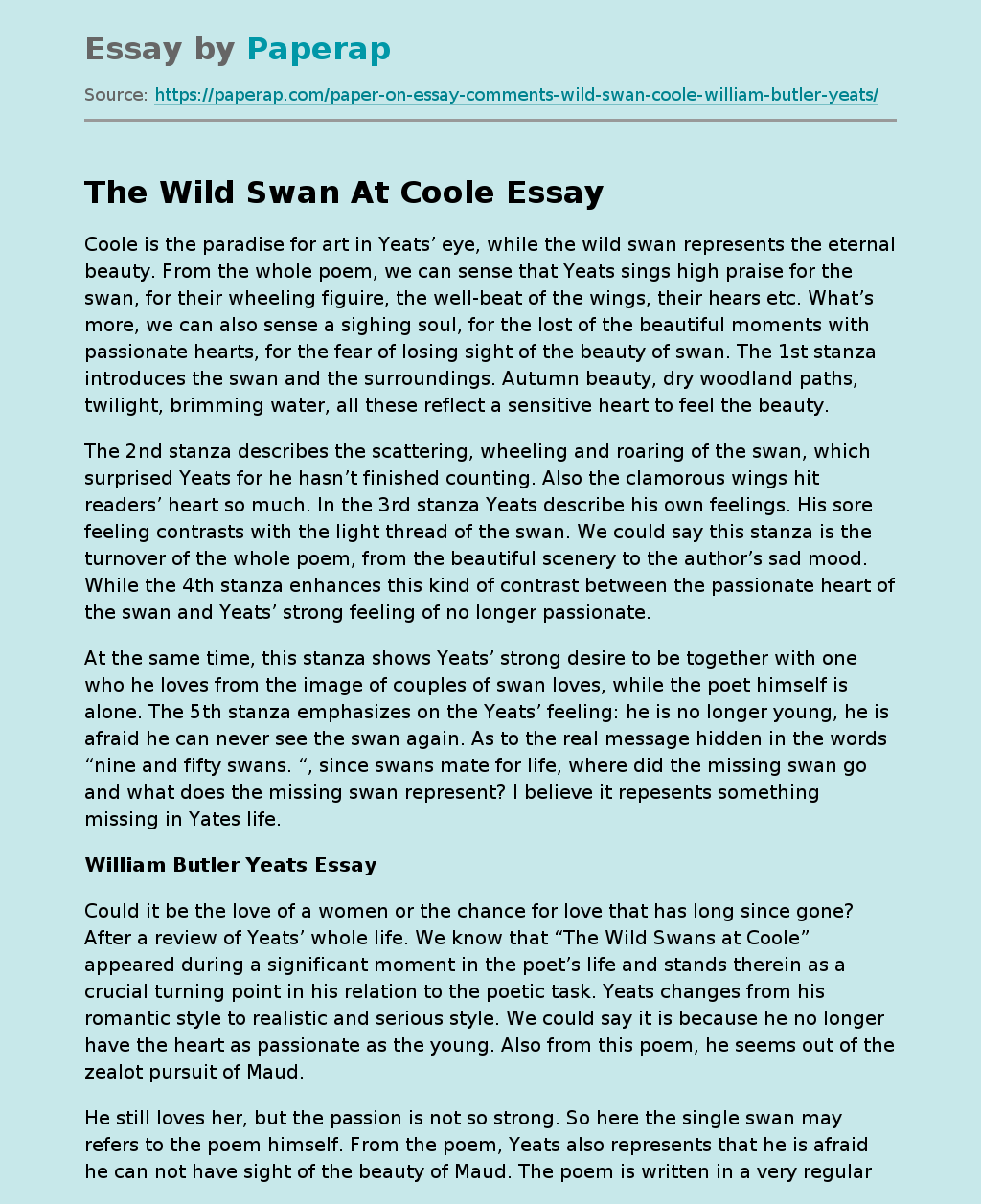The Wild Swan At Coole
Coole is the paradise for art in Yeats’ eye, while the wild swan represents the eternal beauty. From the whole poem, we can sense that Yeats sings high praise for the swan, for their wheeling figuire, the well-beat of the wings, their hears etc. What’s more, we can also sense a sighing soul, for the lost of the beautiful moments with passionate hearts, for the fear of losing sight of the beauty of swan. The 1st stanza introduces the swan and the surroundings.
Autumn beauty, dry woodland paths, twilight, brimming water, all these reflect a sensitive heart to feel the beauty.
The 2nd stanza describes the scattering, wheeling and roaring of the swan, which surprised Yeats for he hasn’t finished counting. Also the clamorous wings hit readers’ heart so much. In the 3rd stanza Yeats describe his own feelings. His sore feeling contrasts with the light thread of the swan. We could say this stanza is the turnover of the whole poem, from the beautiful scenery to the author’s sad mood.
While the 4th stanza enhances this kind of contrast between the passionate heart of the swan and Yeats’ strong feeling of no longer passionate.
At the same time, this stanza shows Yeats’ strong desire to be together with one who he loves from the image of couples of swan loves, while the poet himself is alone. The 5th stanza emphasizes on the Yeats’ feeling: he is no longer young, he is afraid he can never see the swan again.
As to the real message hidden in the words “nine and fifty swans. “, since swans mate for life, where did the missing swan go and what does the missing swan represent? I believe it repesents something missing in Yates life.
William Butler Yeats Essay
Could it be the love of a women or the chance for love that has long since gone? After a review of Yeats’ whole life. We know that “The Wild Swans at Coole” appeared during a significant moment in the poet’s life and stands therein as a crucial turning point in his relation to the poetic task. Yeats changes from his romantic style to realistic and serious style. We could say it is because he no longer have the heart as passionate as the young. Also from this poem, he seems out of the zealot pursuit of Maud.
He still loves her, but the passion is not so strong. So here the single swan may refers to the poem himself. From the poem, Yeats also represents that he is afraid he can not have sight of the beauty of Maud. The poem is written in a very regular stanza form: five six-line stanzas, each written in a roughly iambic meter, with the first and third lines in tetrameter, the second, fourth, and sixth lines in trimeter, and the fifth line in pentameter, so that the pattern of stressed syllables in each stanza is 434353.
The rhyme scheme in each stanza is ABCBDD. The use of rhyme make the poem fluent when you read it. However, after learning more about Yeats, we would wonder does the poem only represents sadness for fear that swan will go when the poet wakes up? After reading the poem for several times, we could sense that although one day Yeats will die, one day his swans will have flown away from him, yet they will delight the eyes of other men, for their image, eternalized in these words he has generated from his own contingent experience, will live on long after him.
In this way, the enduring existence of Yeats’ poem answers the very question its text seems unable to resolve; by creating this textual image of his experience in the dialogue he establishes with the reader, he has, in language itself, found the eternal. He has written of the particular loneliness and mutability he has experienced in his own life, we, ninety years later, read into his poem these emotions such as we have experienced them in our own lives, and between us and him exists this poem, this timeless image of the ephemerality of human existence that will abide long after the churning wheel of the ages has ground us all to dust.
The Wild Swan At Coole. (2019, Dec 05). Retrieved from https://paperap.com/paper-on-essay-comments-wild-swan-coole-william-butler-yeats/

